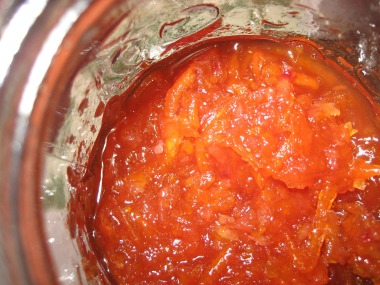 Marmalade is downright unapologetic. If marmalade were a person, she would be flying past you in a cab as you’re about to descend into the train station; she doesn’t pause to wonder what it’s like to carry four monstrous grocery bags home on the subway. Marmalade is luxury at its best.
Marmalade is downright unapologetic. If marmalade were a person, she would be flying past you in a cab as you’re about to descend into the train station; she doesn’t pause to wonder what it’s like to carry four monstrous grocery bags home on the subway. Marmalade is luxury at its best.
For all her high-maintenance appearances, marmalade is probably one of the easiest things for a first-time sweets canner to do. It is downright impossible to fuck up marmalade, that is, unless you cook it to death, against which your cell phone clock/timer will valiantly buffer. Marmalade doesn’t roll like the shower faucet, which as Eddie Izzard describes, is like a fine balance between “here aaaaaand here [never moving his hands], a quarter of a millimeter between fantastically hot and fucking freezing.” Nope, marmalade in the making is rather easy going.
To be completely honest, I hadn’t even tasted marmalade until I made it as my stash of Christmas gifts this past year. It’s a grandma thing, which is actually what inspired me to do it. My Grandma Jinny in Minnesota told me how she likes orange marmalade the best of all jams and jellies. Grandma challenge!
All this said, I’m going to need a separate post—I’m dreaming of working with a videographer to make a demo film—to show you some of the not-so-stressful, but can-be-intimidating-at-first things about canning. Like, for instance, sterilizing a jar: not hard if you’ve ever washed a dish by hand or boiled water before. Even easier if you have a dishwasher (unlike me.) Canning, like the oeuvre of happy home-making in general, literally boils down to common sense and paying attention. So, newbies, please stay tuned for some sort of demo, either photo or video.
Without further ado, please meet my Tigress Can Jam creation of the month:
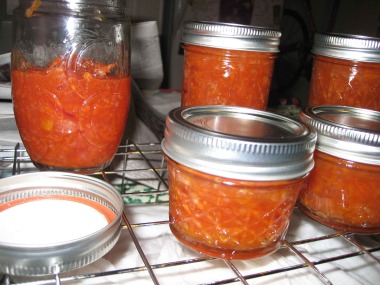 Marmalady of the Night (citrus carrot ch-armalade—chutney/marm straddler). I just love the Tigress’ naming debate for a similar kind of straddler in this post. When Doris & Jilly announced the befuddling ingredient of the month: CARROT, I leaned toward doing another marmalade because I’m new to this, and citrus is still floating through the air, and I haven’t pickled anything yet, so no matter how easy it may be, I’m a little overloaded with projects and work-like things to learn something new at this moment. Plus, there are just so many ways to spruce up a marm (and I know I can’t go wrong!)
Marmalady of the Night (citrus carrot ch-armalade—chutney/marm straddler). I just love the Tigress’ naming debate for a similar kind of straddler in this post. When Doris & Jilly announced the befuddling ingredient of the month: CARROT, I leaned toward doing another marmalade because I’m new to this, and citrus is still floating through the air, and I haven’t pickled anything yet, so no matter how easy it may be, I’m a little overloaded with projects and work-like things to learn something new at this moment. Plus, there are just so many ways to spruce up a marm (and I know I can’t go wrong!)
Marmalady of the Night Recipe
adapted from Mary Anne Dragan’s Carrot Marmalade Recipe, kindly shared by Talia at innBrooklyn
This charmalade is an evening, cocktail affair. This vibrant orange, sweetly savory mixture makes me want to dress up, make martinis and have friends over for hors d’ oeuvres. I’m thinking cracker with sharp or stinky cheese topped with a dollop of this orange mayhem. Or spruce up a chicken or pork dish with it. Or brazenly eat it on toast in the morning, whatevs.
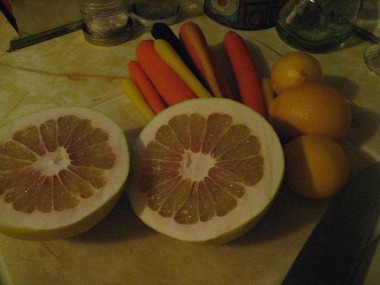
Step 1: Gather your ingredients. You’ll need:
1 pomelo or grapefruit
2 large or 3 small Meyer lemons
a bunch o’ carrots (I had a bundle—approx 10 skinny small—of multi-colored carrots and 3 large orange ones)
3 cups sugar
1/2 teaspoon salt
1 teaspoon coriander (or spice(s) of choice!)
Step 2: Prepare the carrots and citrus
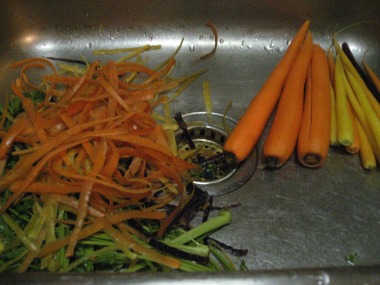 Peel ‘em
Peel ‘em citrus massacrePomelo prep: halve it. juice it. remove any escapist seeds, throw in some of the good pulp from the juice strainer thing.
citrus massacrePomelo prep: halve it. juice it. remove any escapist seeds, throw in some of the good pulp from the juice strainer thing.
Meyer lemon prep: halve ‘em. juice them. scrape out as much pith and such from 4 of the rind halves (continue to scrape on the juicer). Chop or food process the empty rinds.
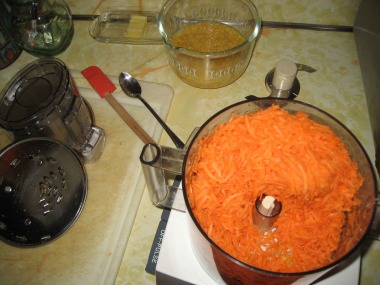 The best $80 I’ve ever spent on Craigslist: CUISINART.Carrot prep: grate by hand on the large side of your grater. OR two words: FOOD PROCESSOR. I’ve upgraded to a rockstar machine and haven’t been happier with an appliance (well, perhaps aside from my free bread machine.)
The best $80 I’ve ever spent on Craigslist: CUISINART.Carrot prep: grate by hand on the large side of your grater. OR two words: FOOD PROCESSOR. I’ve upgraded to a rockstar machine and haven’t been happier with an appliance (well, perhaps aside from my free bread machine.)
I ended up with 6 cups of carrot/citrus pulp (4 cups carrot, 2 cups citrus.) The cool thing about marmalade is that you can use whatever combination/prep type for the citrus here. i.e. you can relax about recipe-following in canning for the first time!
Step 3: Throw carrot/citrus pulp in your heaviest-bottom stockpot/pan (copper bottom if you’ve got it.) Add sugar, salt and coriander. Let sit for an hour (while you clean up the prep mess and sterilize your jars.)
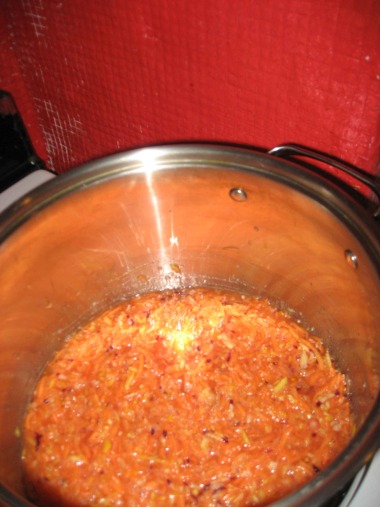
At this point, taste the mix. Add more coriander, or use a different spice entirely. Your first taste of your creation should not be upon popping open a sealed jar! Spice combinations are flexible, sugar ratio is arguably flexible, just don’t cut down the citrus ratio with such a low acidity food as carrots. Carrots (without citrus) usually have to be pressure canned for safety in preservation.
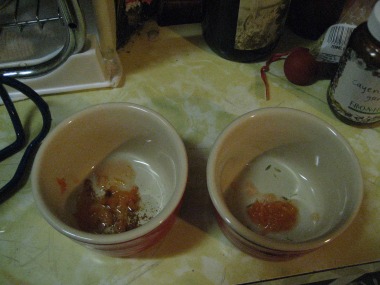 I thought cayenne first, then fennel. Didn’t end up liking either!
I thought cayenne first, then fennel. Didn’t end up liking either!
Step 4: Put on a pair of comfortable shoes (yes, I’m serious, not just evoking lesbian humor.) Bring mix to a boil over medium heat, stirring every few minutes to incorporate all ingredients. Once boiling, reduce heat to med-low and cook at a rapid boil for 30 min. FYI, when you stir, it will calm the boil; don’t worry about that. The catch at this step is that you’ve gotta stick near the pot, stirring pretty consistently—especially if you’re using a cheaper pot (not copper bottomed)—so you don’t burn the sugar. (See why the shoes will come in handy?)
Step 5: Remove from heat. Ladle mixture into hot jars (hot just means still hot from being sterilized in boiling water, in your canner pot.) Wipe rims clean of any wayward, sticky goo with a clean cloth. Place prepared lids (which are warmed on stove in small saucepan of water, not boiled) on jars and screw bands on finger-tight (closed tightly but not so much that you’ll need to phone a friend to open it.) Put jars in your canner.
Step 6: Start the timer (and process) for 10 minutes when your canner pot reaches a rapid boil.
In retrospect, I wish I’d have used more purple carrots, the measly one I had sort of faded into the orange-y hues of this mixture. I’d love opinions on further sugar reduction here; though the mix was rather thick with carrots, I think so long as they’re simply coated with the syrup it’d be okay. Dropping the sugar a tad more might help make it more of a savory, true citrus chutney.
